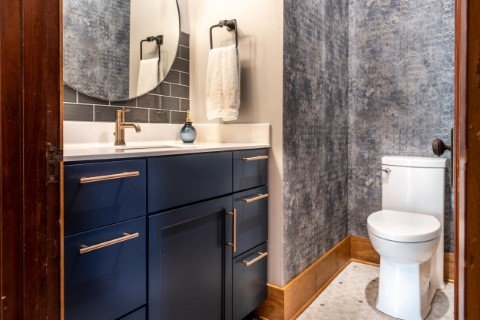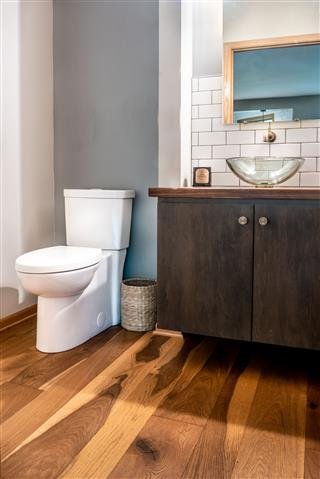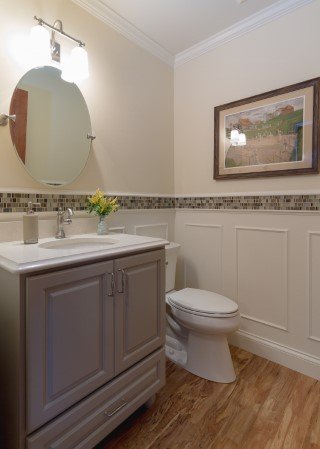Adding a Half-Bath or Powder Room When Remodeling
/What is a half-bath?
A half-bath, also known as a powder room consists of two of the four main elements of a traditional bathroom – typically a toilet and a sink. Usually located on the main floor near the living area of a multistory home, it's used by guests and family members who don't want to run upstairs when nature calls.
Creating the right layout for your powder room is the key to your guest's comfort and can add to your home's value. A powder room is convenient and doesn't compromise anyone's privacy. (Who wants friends to see dirty laundry and prescription bottles!)
Depending on your home's layout, there are several ways to add a half bath by borrowing space from your existing floor plan. Here are several options that can work.
Where to Put a Half-Bath
Typically, powder rooms are located near the entry and public rooms (foyer, living and dining rooms) to make them most accessible for your guests. If you live in an older home and are thinking about adding a powder room, consider an area near the main floor entertaining areas of your home. This can be a recessed area underneath a staircase, a large coat closet near the entrance, or even carved from space in the garage.
View Our Bathroom Remodeling Portfolio
You'll have several factors to consider when determining the location of your powder room. Keep in mind which wall you plan on using for plumbing since it can be noisy if shared with a living or dining room. Besides being centrally located, you should try to place your powder room near or adjacent to the plumbing lines so you can use the existing water and waste systems in your home. If you need to run new plumbing and vent lines behind walls and under floors boards, it can add considerably to the cost of your project.
How Much Space Do You Need For A Half-Bath
The minimum size of a half-bath really depends on the space you have available, and any local building codes that may be in place. No national code governs the size of residential rooms, but most localities follow the guidelines set by the International Residential Code. The IRC's minimum requirements for clearances and ventilation suggest certain basic configurations.
• The minimum distance from the toilet centerline to a sidewall is 15 inches.
• The minimum clearance in front of a toilet is 21 inches.
• The minimum ceiling height is 7 feet.
• Windows must be at least 3 square feet, at least 1 ½ feet must be openable.
• A fan with a minimum of 50 CFM of ventilation can substitute for a window.
WISCONSIN TIP: Wisconsin is governed by the Uniform Dwelling Code (UDC). The code requirements for a powder room are consistent throughout the state and are substantially similar to the requirements listed here.
In a small space, door placement, size, and swing are important. The IRC has no rules for powder room doors size, and the door can swing in or out. An outswing prevents an occupant from wedging the door shut in the event of a fall, and it allows for more options when it comes to layout.
However, an outswing door can be dangerous for those outside the room, so location should be considered in light of the flow of the space, and the traffic in the area. If a pocket door is possible, that can be a great option as pocket doors take no floor space to open.
Choosing The Right Fixtures and Sinks for Your Half-Bath
Today, smaller fixtures can make adhering to codes easier. Sinks are available in small sizes, shapes, and configurations that maximize floor space. These include wall hung sinks, corner sinks, and special pedestal sinks. Bowls mounted on wrought iron or hammered bronze pedestal stands work well in small spaces and add a beautiful design element. Lever action faucets fit better on small sinks and are excellent if older people are living in the home.
If the layout requires a toilet to be placed in the corner of the room, a narrower tank allows the toilet to fit closer to the wall. Today, manufacturers are making triangular toilet tanks that are perfect for a small space. Clever solutions like recessing the toilet tank into the wall between the studs can also free up space in a small power room.
Traditionally, a half-bath will have the toilet and sink against one wall to make sharing plumbing and waste lines easier. The fixtures are usually situated, so the sink is visible when the door is open, becoming the room's focal point. Other half-bath layouts which place the toilet and sink on different walls can be more expensive because this configuration will require additional plumbing, venting, and waste lines.
The final layout of your powder room is determined by the space you have available and your budget.
Adding a powder room to your home is a good investment that will add convenience for both your family and friends and will add value to your home when it comes time to sell.
This article was updated by Abe J Degnan on 6/17/2019.
Additional Articles On Bathroom Design and Remodeling
Choosing the Perfect Finish For Your Bathroom Water Faucet
Choosing Grout Color For Kitchen and Bathroom Tile Design
Choosing a Shower Head Style For A Master Bathroom Remodel
Learn The Value of A Bathroom Remodel In Wisconsin
If you live in the greater Madison, Wisconsin area and you're considering adding a half-bath to your home give the experts at Degnan Design Build Remodel a call (608) 846-5963.
We can help you find the perfect location for your half-bath. If you're planning a more extensive remodeling project, for example, a kitchen renovation, including a half-bath into your project can be a cost-effective way to add value. Let our designers help you to create the perfect powder room to meet your needs.

















